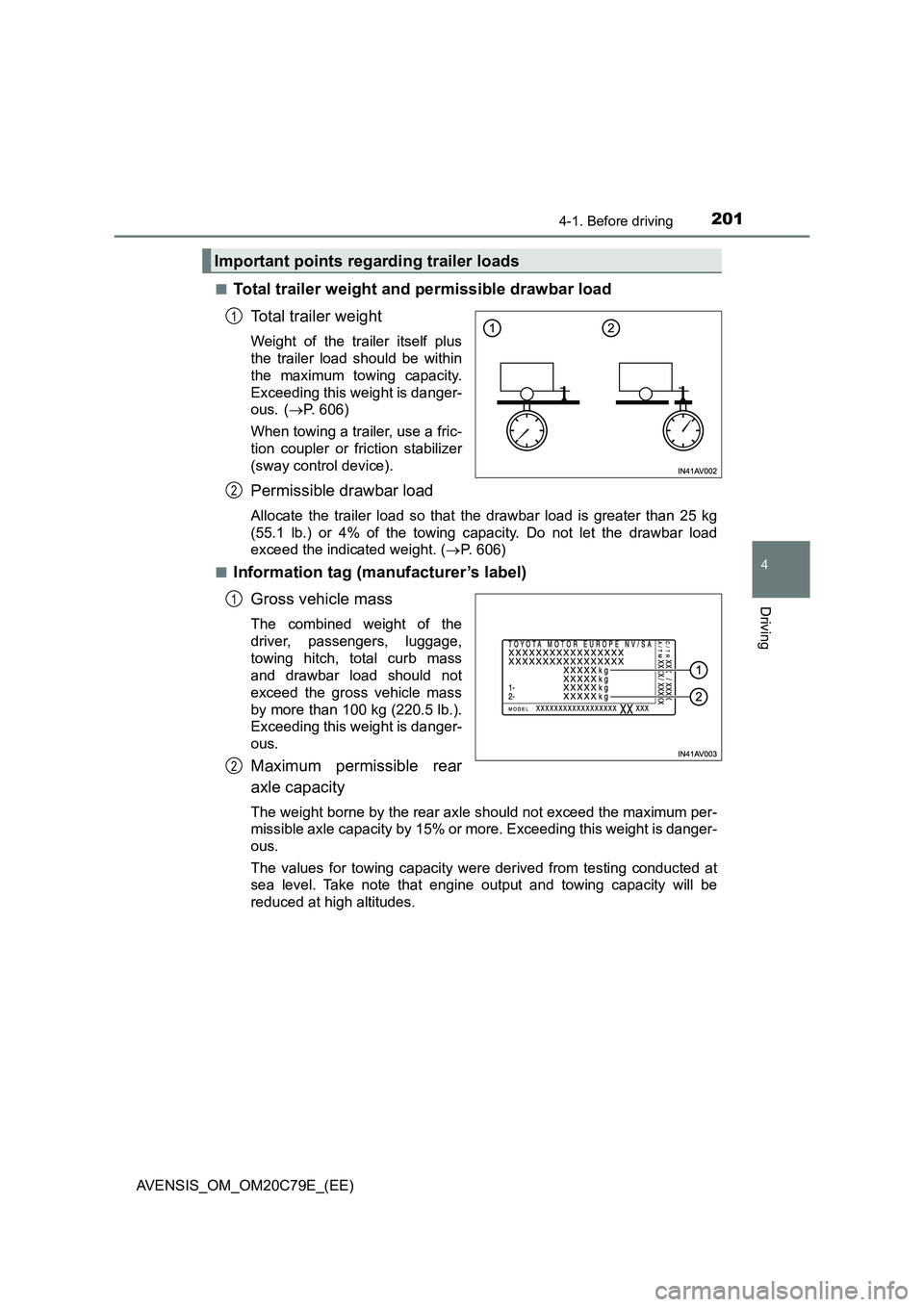Page 200 of 660

2004-1. Before driving
AVENSIS_OM_OM20C79E_(EE)
Trailer towing
◆Weight limits
Check the allowable towing capacity, GVM (Gross Vehicle Mass),
MPAC (Maximum Permissible Axle Capacity), and permissible
drawbar load before towing. (P. 606)
◆Towing hitch/bracket
Toyota recommends the use of the Toyota hitch/bracket for your
vehicle. Other products of a suitable nature and comparable quality
may also be used.
Your vehicle is designed primarily as a passenger carrying vehi-
cle. Towing a trailer will have an adverse effect on handling, per-
formance, braking, durability, and fuel consumption. Your safety
and satisfaction depend on the proper use of correct equipment
and cautious driving habits. For your safety and the safety of
others, do not overload the vehicle or trailer.
To tow a trailer safely, use extreme care and drive the vehicle in
accordance with the trailer’s characteristics and operating con-
ditions.
Toyota warranties do not apply to damage or malfunction
caused by towing a trailer for commercial purposes.
Ask your local authorized Toyota retailer or Toyota authorized
repairer, or any reliable repairer, for further details before tow-
ing, as there are additional legal requirements in some coun-
tries.
Page 201 of 660

2014-1. Before driving
4
Driving
AVENSIS_OM_OM20C79E_(EE)
■Total trailer weight and permissible drawbar load
Total trailer weight
Weight of the trailer itself plus
the trailer load should be within
the maximum towing capacity.
Exceeding this weight is danger-
ous. ( P. 606)
When towing a trailer, use a fric-
tion coupler or friction stabilizer
(sway control device).
Permissible drawbar load
Allocate the trailer load so that the drawbar load is greater than 25 kg
(55.1 lb.) or 4% of the towing c apacity. Do not let the drawbar load
exceed the indicated weight. ( P. 606)
■Information tag (manufacturer’s label)
Gross vehicle mass
The combined weight of the
driver, passengers, luggage,
towing hitch, total curb mass
and drawbar load should not
exceed the gross vehicle mass
by more than 100 kg (220.5 lb.).
Exceeding this weight is danger-
ous.
Maximum permissible rear
axle capacity
The weight borne by the rear axle should not exceed the maximum per-
missible axle capacity by 15% or more. Exceeding this weight is danger-
ous.
The values for towing capacity were derived from testing conducted at
sea level. Take note that engine output and towing capacity will be
reduced at high altitudes.
Important points regarding trailer loads
1
2
1
2
Page 202 of 660
2024-1. Before driving
AVENSIS_OM_OM20C79E_(EE)
WARNING
■When the gross vehicle mass or maximum permissible axle capacity is
exceeded
Failing to observe this precaution may lead to an accident causing death or
serious injury.
● Add an additional 20.0 kPa (0.2 kgf/cm2 or bar, 3 psi) to the recommended
tire inflation pressure value. ( P. 623)
● Do not exceed the established speed limit for towing a trailer in built-up
areas or 100 km/h (62 mph), whichever is lower.
Page 607 of 660
6079-1. Specifications
AVENSIS_OM_OM20C79E_(EE)
9
Vehicle specifications
*1: Unladen vehicles
*2: 205/60R16 tires
*3: 215/55R17 and 225/45R18 tires
*4: Vehicles with a Multidrive
*5: Vehicles with a manual transmission
Drawbar load 75 kg (165.3 lb.)
Towing capacityWith brake
1ZR-FAE engine
1400 kg (3086.5 lb.)
2ZR-FAE engine
1600 kg (3527.4 lb.)
*4
1500 kg (3306.9 lb.)*5
3ZR-FAE engine
1800 kg (3968.3 lb.)
1WW engine
1600 kg (3527.4 lb.)
2WW engine
1800 kg (3968.3 lb.)
Without brake 500 kg (1102.3 lb.)